WGU D236 pathophysiology Exam -Study Guide latest updated Graded A+
Document Content and Description Below
What is Starling's Law of Capillary forces? How does this explain why a nutritionally deficient child would have edema? - ANSWER Starling's Law describes how fluids move across the capillary membr... ane. There are two major opposing forces that act to balance each other, hydrostatic pressure (pushing water out of the capillaries) and osmotic pressure (including oncontic pressure, which pushes fluid into the capillaries). Both electrolytes and proteins (oncontic pressure) in the blood affect osmotic pressure, high electrolyte and protein concentrations in the blood would cause water to leave the cells and interstitial space and enter the blood stream to dilute the high concentrations. On, the other hand, low electrolyte and protein concentrations (as seen in a nutritionally deficient child) would cause water to leave the capillaries and enter the cells and interstitial fluid which can lead to edema. How does the RAAS (Renin-Angiotensin-Aldosterone System) result in increased blood volume and increased blood pressure? - ANSWER A drop in blood pressure is sensed by the kidneys by low perfusion, which in turn begins to secrete renin. Renin then triggers the liver to produce angiotensinogen, which is converted to Angiotensin I in the lungs and then angiotensin II by the enzyme Angiotensin-converting enzyme (ACE). Angiotensin II stimulates peripheral arterial vasoconstriction which raises BP. Angiotensin II is also stimulating the adrenal gland to release aldosterone, which acts to increase sodium and water reabsorption increasing blood volume, while also increased potassium secretion in urine. How can hyperkalemia lead to cardiac arrest? - ANSWER Normal levels of potassium are between 3.5 and 5.2 mEq/dL. Hyperkalemia refers to potassium levels higher that 5.2 mEq/dL. A major function of potassium is to conduct nerve impulses in muscles. Too low and muscle weakness occurs and too much can cause muscle spasms. This is especially dangerous in the heart muscle and an irregular heartbeat can cause a heart attack The body uses the Protein Buffering System, Phosphate Buffering System, and Carbonic Acid-Bicarbonate System to regulate and maintain homeostatic pH, what is the consequence of a pH imbalance - ANSWER Proteins contain many acidic and basic group that can be affected by pH changes. Any increase or decrease in blood pH can alter the structure of the protein (denature), thereby affecting its function as well Describe the laboratory findings associated with metabolic acidosis, metabolic alkalosis, respiratory acidosis and respiratory alkalosis. (ie relative pH and CO2 levels). - ANSWER Normal ABGs (Arterial Blood Gases) Blood pH: 7.35-7.45 PCO2: 35-45 mm Hg PO2: 90-100 mm Hg HCO3-: 22-26 mEq/L SaO2: 95-100% Respiratory acidosis and alkalosis are marked by changes in PCO2. Higher = acidosis and lower = alkalosis Metabolic acidosis and alkalosis are caused by something other than abnormal CO2 levels. This could include toxicity, diabetes, renal failure or excessive GI losses. Here are the rules to follow to determine if is respiratory or metabolic in nature. -If pH and PCO2 are moving in opposite directions, then it is the pCO2 levels that are causing the imbalance and it is respiratory in nature. -If PCO2 is normal or is moving in the same direction as the pH, then the imbalance is metabolic in nature. The anion gap is the difference between measured cations (Na+ and K+) and measured anions (Cl- and HCO3-), this calculation can be useful in determining the cause of metabolic acidosis. Why would an increased anion gap be observed in diabetic ketoacidosis or lactic acidosis? - ANSWER The anion gap is the calculation of unmeasured anions in the blood. Lactic acid and ketones both lead to the production of unmeasured anions, which remove HCO3- (a measured anion) due to buffering of the excess H+ and therefore leads to an increase in the AG. Why is it important to maintain a homeostatic balance of glucose in the blood (ie describe the pathogenesis of diabetes)? - ANSWER Insulin is the hormone responsible for initiating the uptake of glucose by the cells. Cells use glucose to produce energy (ATP). In a normal individual, when blood glucose increases, the pancreas is signaled to produced in insulin, which binds to insulin receptors on a cells surface and initiates the uptake of glucose. Glucose is a very reactive molecule and if left in the blood, it can start to bind to other proteins and lipids, which can lead to loss of function. AGEs are advanced glycation end products that are a result of glucose reacting with the endothelial lining, which can lead to damage in the heart and kidneys. Compare and contrast Type I and Type II Diabetes - ANSWER Type I diabetes is caused by lack of insulin. With out insulin signaling, glucose will not be taken into the cell and leads to high blood glucose (hyperglycemia). Type I is usually treated with insulin injections. Type II diabetes is caused by a desensitization to insulin signaling. The insulin receptors are no longer responding to insulin, which also leads to hyperglycemia. Type II is usually treated with drugs to increase the sensitization to insulin (metformin), dietary and life-style changes or insulin injections. Describe some reasons for a patient needing dialysis - ANSWER AEIOU-acidosis. Electrolytes, Intoxication/Ingestion, overload, uremia. Patients with kidney or heart failure. A build up of phosphates, urea and magnesium are removed from the blood using a semi-permeable membrane and dialysate. AEIOU: A—acidosis; E—electrolytes principally hyperkalemia; I—ingestions or overdose of medications/drugs; O—overload of fluid causing heart failure; U—uremia leading to encephalitis/pericarditis Compare and contrast hemodialysis and peritoneal dialysis. What are some reasons for a patient choosing one over the other? - ANSWER Hemodialysis uses a machine to pump blood from the body in one tube while dialysate (made of water, electrolytes and salts) is pumped in the separate tube in the opposite direction. Waste from the blood diffuses through the semipermeable membrane separating the blood from the dialysate. Peritoneal Dialysis does not use a machine, but instead injects a solution of water and glucose into the abdominal cavity. The peritoneum acts as the membrane instead of dialysis tubing. The waste products diffuse into the abdominal cavity and the waste solution is then drained from the body. Peritoneal dialysis offers continuous filtration and is less disruption to the patient's daily routines. However, it does require some training of the patient and is not recommended for individuals who are overweight or have severe kidney failure. Hemodialysis provides medical care, but 3 times a week for several hours sitting at a hospital or clinic. Individuals with acute kidney failure are recommended to use hemodialysis. How does homeostasis and maintaining optimal physiological health impact your wellbeing? - ANSWER Homeostasis acts to create a constant and stable environment in the body despite internal and external changes. Proteins and other cellular processes require optimal conditions in order to carry out their functions. Alterations in pH, salt concentration, temperature, glucose levels, etc. can have negative effects on health, so it is vital for mechanisms that regulate homeostasis to function properly for maintaining good health Differentiate between Innate Immunity and Adaptive Immunity ? - ANSWER The innate immune system encompasses physical barriers and chemical and cellular defenses. Physical barriers protect the body from invasion. These include things like the skin and eyelashes. Chemical barriers are defense mechanisms that can destroy harmful agent. Examples include tears, mucous, and stomach acid. Cellular defenses of the innate immune response are non-specific. These cellular defenses identify pathogens and substances that are potentially dangerous and takes steps to neutralize or destroy them. Adaptive immunity is an organism's acquired immunity to a specific pathogen. As such, it's also referred to as acquired immunity. Adaptive immunity is not immediate, nor does it always last throughout an organism's entire lifespan, although it can. The adaptive immune response is marked by clonal expansion of T and B lymphocytes, releasing many antibody copies to neutralize or destroy their target antigen What is a way that Adaptive Immunity can recruit innate immunity? - ANSWER The innate immune response to microbes stimulates adaptive immune responses and influences the nature of the adaptive responses. Conversely, adaptive immune responses often work by enhancing the protective mechanisms of innate immunity, making them more capable of effectively combating pathogenic microbes Why are some infections harder on children while other infections are harder on the elderly? - ANSWER Children have not been exposed to many pathogens yet, so they lack memory cells and have not built-up immunity yet. The elderly have a depleted naïve T cell population from years of battling infections, so the likelihood of getting a match is less. Describe how and why our injury response results in the signs of redness, swelling, heat, and pain? (Be sure to use chemokines, histamine, and vasodilation in your response.) - ANSWER An injury causes an inflammatory response which is responsible for the redness, swelling, heat and pain. Upon injury, cells on the surface begin to release chemokines which act as messengers that something has happened. Mast cells are also alerted to release histamines which travel to the endothelial cells of capillaries and causes vasodilation, which is related to swelling and redness. Vasodilation also causes the capillaries to become leaky which allows for histamines, chemokines and even pathogen particles to enter the blood stream where they are met by neutrophils (non-specific) which start to adhere to the capillary wall and squeeze through the leaky holes (diapedesis or extravasation) to phagocytose pathogens and damaged cells. Dendritic cells just under the surface of skin are also activated to phagocytose foreign particles. Other B cells, T cells (specific) and the complement system also squeeze through the capillary wall to create an area of congestion. Explain dominant vs recessive genetic diseases. What is a "carrier" in recessive genetic diseases? - ANSWER The human genome contains 23 pairs of chromosome (22 autosomes and 1 pair of sex chromosomes). The pairs are homologous and contain the same genes in the same order. This means that every gene has a copy, one inherited from your mother and the other from your father. Not all versions of a gene (alleles) are treated the same by the cell. Some are expressed over others. A dominant gene is a gene that is expressed, even if you only have one copy. The dominant gene will be expressed over the recessive gene, which must have two copies to be expressed. In a dominant genetic disease, all it takes is one copy of the disease to have the disease. Recessive genetic diseases require that the individual gets two copies of the gene to have the disease. Someone who is a carrier for a recessive genetic disease is healthy, but contains a copy of the disease gene, potentially passing it to their offspring. Describe how to determine the probability of clinical outcomes given information about the parents (eg two heterozygous carriers of sickle cell disease). - ANSWER Punnett Squares can be used to determine the potential probabilities of certain traits being passed to offspring. If you know the genotypes of each parent (ie homozygous or heterozygous for the trait), you can determine the possible outcomes. Heterozygous means that the parent has one copy of each gene, homozygous means the parent has the same copy for each gene (either both dominant genes or both recessive genes). What are some of the consequences of alcohol exposure in pregnancy? - ANSWER ND-PAE (neurobehavioral disorder-prenatal alcohol exposure) can cause birth defects and developmental disabilities (fetal alcohol spectrum disorders-FASDs). Affects thinking and memory, causes behavioral issues and linked to trouble with everyday functioning What are some of the distinctive features associated with trisomy 21, or Down's Syndrome? Why is increased maternal age a risk factor? - ANSWER Distinct features of Down's syndrome include intellectual disabilities and common physical features that include slanted eyes, flattened bridge of the nose and forehead, short in stature, poor muscle tone, loose joints and single palmar crease. As a woman's eggs age, they can have mistakes in meiosis potentially leading to a nondisjunction event causing trisomy 21 What is Spina Bifida? Why are relative deficiencies in Folic acid or B12 associated with Spina Bifida? - ANSWER Failure to close the neural tube early in gestation due to low folic acid and B-12. These vitamins help activate DNA synthesis in the developing fetus in the first 4 weeks of pregnancy, that are responsible for closing up the spinal column. Three types of spina bifida. 1) spina bifida occulta (most common, less severe) 2) Meningocele (least common) 3) Myelomeningocele (most severe). Essential Question: How does the body's cellular responses and adaptations react to disruptions? - ANSWER The body uses the RAAS system to regulate blood volume and pressure, the immune response reacts to fight infection, the inflammatory response reacts to injury Describe how calcitonin, parathyroid hormone, and calcitriol (Vitamin D) work together to maintain normal blood calcium levels. - ANSWER Vitamin D: UV light stimulates formation of cholecalciferol, which is hydroxylated in the liver and the kidney into the active form of Vitamin D, calcitriol. Calcitriol stimulates absorption of calcium and phosphorus from the GI tract in the intestine and phosphate in the kidney. Calcitriol increases the calcification of osteoid. Calcitriol also stimulates the formation of bone by raising the levels of calcium and phosphorus in the blood. Low vitamin D levels can cause hypocalcemia, which stimulates the parathyroid gland to release parathyroid hormone (PTH). PTH stimulates osteoclasts to resorb bone calcium to increase blood calcium levels. PTH also stimulates osteoblasts to form bone. PTH stimulates kidneys to reabsorb calcium into the blood and to synthesize vitamin D. When blood calcium gets too high, the thyroid is stimulated to release calcitonin (suppresses osteoclast activity and calcium will be used to form bone). Describe the function of osteocytes within lacunae of bone - ANSWER Osteocytes absorb nutrients from the bloodstream and distribute them within the bone structure. Osteocytes absorb waste products from the bone and excrete them into the bloodstream. Describe bone remodeling ? Which cells are involved in this process and what is their function? - ANSWER Osteoclasts breakdown older bone structure and secrete the release calcium into the bloodstream. Osteoblasts absorb calcium from the bloodstream and use it to build new bone structure. Working together, these two cell types allow for regeneration of damaged bone structure. Describe the process of articular degeneration. Which cells are involved in this process and what is their function? - ANSWER Articular Degeneration is the thinning and breakdown of the articular cartilage that covers joints and acts as a lubricant and cushion. This articular cartilage is comprised of chondrocytes in a matrix of collagen and aggrecan. The chondrocytes produce enzymes and other proteins that slowly break down and reform the matrix, allowing for regeneration. Stress caused by being overweight or physical trauma can cause chondrocytes to speed up the matrix breakdown process relative to the reformation process, leading to a thinning of the articular cartilage. What is rickets? How does it develop? Who usually develops rickets? How can rickets be treated? - ANSWER Rickets is, primarily, due to a deficiency of vitamin D (due to sunlight exposure), which leads to a deficiency of blood calcium. Rickets can lead to bone weakness, deformity, and susceptibility to fracture. Rickets results from a failure to calcify osteoid due to low amounts of blood calcium and low vitamin D (typically). There are many different types of rickets. Children, especially under age 2, are most likely to be diagnosed with rickets. Infants can develop rickets if their mother's diet was low in vitamin D or in calcium, and breastmilk is low in vitamin D, so mother and baby need to supplement vitamin D (and calcium). The best way to treat rickets is to prevent it by taking supplements of vitamin D and calcium, eating food/drink containing vitamin D/calcium, and getting sufficient sunlight. Physical therapy with weight-bearing exercise can help to treat rickets, as well. It is a multi step process to make the active form of Vit D How does Denosumab treat osteoporosis? - ANSWER Denosumab is a monoclonal antibody that binds to osteoclasts and inhibits their Calcium- withdrawing capability. Distinguish between open reduction and internal fixation (ORIF) and hip replacement surgery. - ANSWER Open reduction and internal fixation involves "surgical opening' and insertion of hardware into the patient that assists with maintaining proper bone alignment during the healing process. Hip replacement involves replacement of a fractured hip joint with a prosthesis. What is degenerative disc disease? What are some of the anatomical features of degenerative disc disease? What are some symptoms of lumbar vs. cervical degenerative disc disease? - ANSWER Degenerative disc disease (DDD) is a disorder of the intervertebral discs. When the discs deteriorate, they cause improper alignment of the spinal column. Some anatomical issues that result are thinning discs, herniated discs (nucleus pulposus leaking through annulus fibrosus cartilage), bulging discs, and degenerated discs (possible with the formation of osteophytes). Lumbar DDD results in pain in the buttock and thighs that gets worse with sitting, bending, lifting or twisting; weakness and numbness in the lower body, such as sciatica. Cervical DDD can result in chronic neck pain that radiates to shoulders and down the arms, weakness of arms/hands, and numbness and tingling in arms/hands. What is sepsis ? What are symptoms of sepsis, and how can sepsis be treated? - ANSWER Sepsis is an infection of the blood. Fever, chills, and increased pressure in the affected area are symptoms, as well as the area of injury will be warm, edematous, and erythematous. If the infection is advanced, a purulent (pus-like) discharge can develop, as well as a foul odor. The patient is treated with IV antibiotics in the hospital. When they are allowed to go home, they are given oral antibiotics. In the context of musculoskeletal injury, as part of treatment, the debridement of the wound and removal of orthopedic hardware will be needed to clean up infected region around injury, if it exists. How does compartment syndrome develop? Which part of our body tends to develop compartment syndrome? How do patients typically recognize they may need to seek medical assistance for rhabdomyolysis? What is the most sensitive laboratory test for rhabdomyolosis? - ANSWER Because the fascia around the muscles, nerves and blood vessels do not stretch, compartments surrounded by fascia cannot tolerate swelling or bleeding internally. When this happens, tissue pressure can exceed perfusion pressure, and compartment syndrome develops. The area can feel very hard due to the pressure. It is common in the lower leg and the forearm, and can be present in several potential body compartments. Several issues develop, and then exacerbate, the compartment syndrome, including constriction of veins, then arteries and compressed nerves. These lead to tissue necrosis, ischemia, leaky capillaries, and edema. This gives even higher pressure and can lead to increase Mb in the blood as muscles break down (rhabdomyolysis). Mb in the kidneys can lead to renal toxicity and tea-colored urine, which is, typically, a patient's first indication that they have rhabdomyolysis. The most sensitive laboratory test is an elevated creatine What is a pulmonary embolism? What is a fat embolism? When might a patient develop a pulmonary embolism? When might a patient develop a fat embolism? How are they treated? - ANSWER A pulmonary embolism is a blood clot that has obstructed an artery in the lungs. A fat embolism occurs when fat globules released from marrow of a fractured bone block microvasculature in the lung or other organs, such as the brain. A pulmonary embolism may often develop due to orthopedic surgery and in individuals with low mobility and blood hypercoagulation tendency. Anticoagulant may be administered during orthopedic surgery, and DVT may be treated through thrombolysis or pulmonary thrombectomy. A fat embolism is often related to a deep fracture of a marrow-containing bone, such as the femur. Early stabilization of marrow- containing bone fractures can help prevent fat embolisms, and fat embolisms may be treated by flushing the blood with solutions containing albumin to increase blood vessel volume and to dissolve the fat globules with the aid of the albumin. Choose three of the seven roles (of your choice) of the integumentary system. Describe the vital physiological function that each role serves. Provide at least two examples that illustrate the function for each role you have chosen. - ANSWER 1) Indicator of general health. Changes in the color of skin or nailbeds can indicate diseases of heart, liver, or blood cell synthesis. Examples: see slides provided. Anemia /shock: pallor. Oxygen deficit: blue skin. 2) Barrier protection. Protect body from chemical and environmental hazards. The stratum corneum is a barrier to antigens and is waterproof. 3) Thermoregulation. Maintain a constant body temperature. Temperature sensors in the dermis send signal to thermoregulatory center in hypothalamus. If warm, will sweat and have capillary dilation. If cold, hairs stand up, surface vessels constrict, and body shivers. [Show More]
Last updated: 1 year ago
Preview 1 out of 36 pages
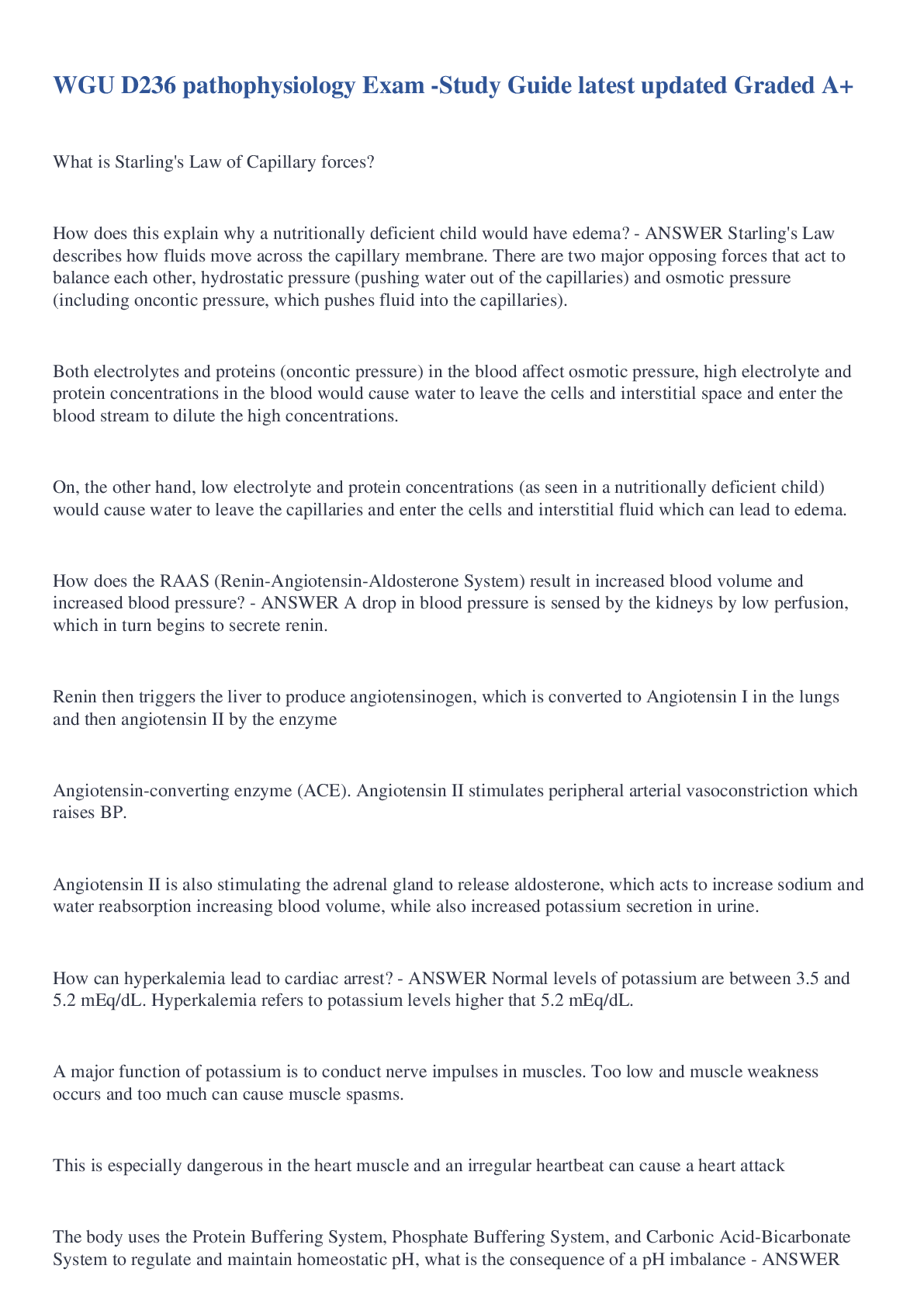
Buy this document to get the full access instantly
Instant Download Access after purchase
Add to cartInstant download
We Accept:

Reviews( 0 )
$10.00
Document information
Connected school, study & course
About the document
Uploaded On
Oct 15, 2022
Number of pages
36
Written in
Additional information
This document has been written for:
Uploaded
Oct 15, 2022
Downloads
0
Views
38

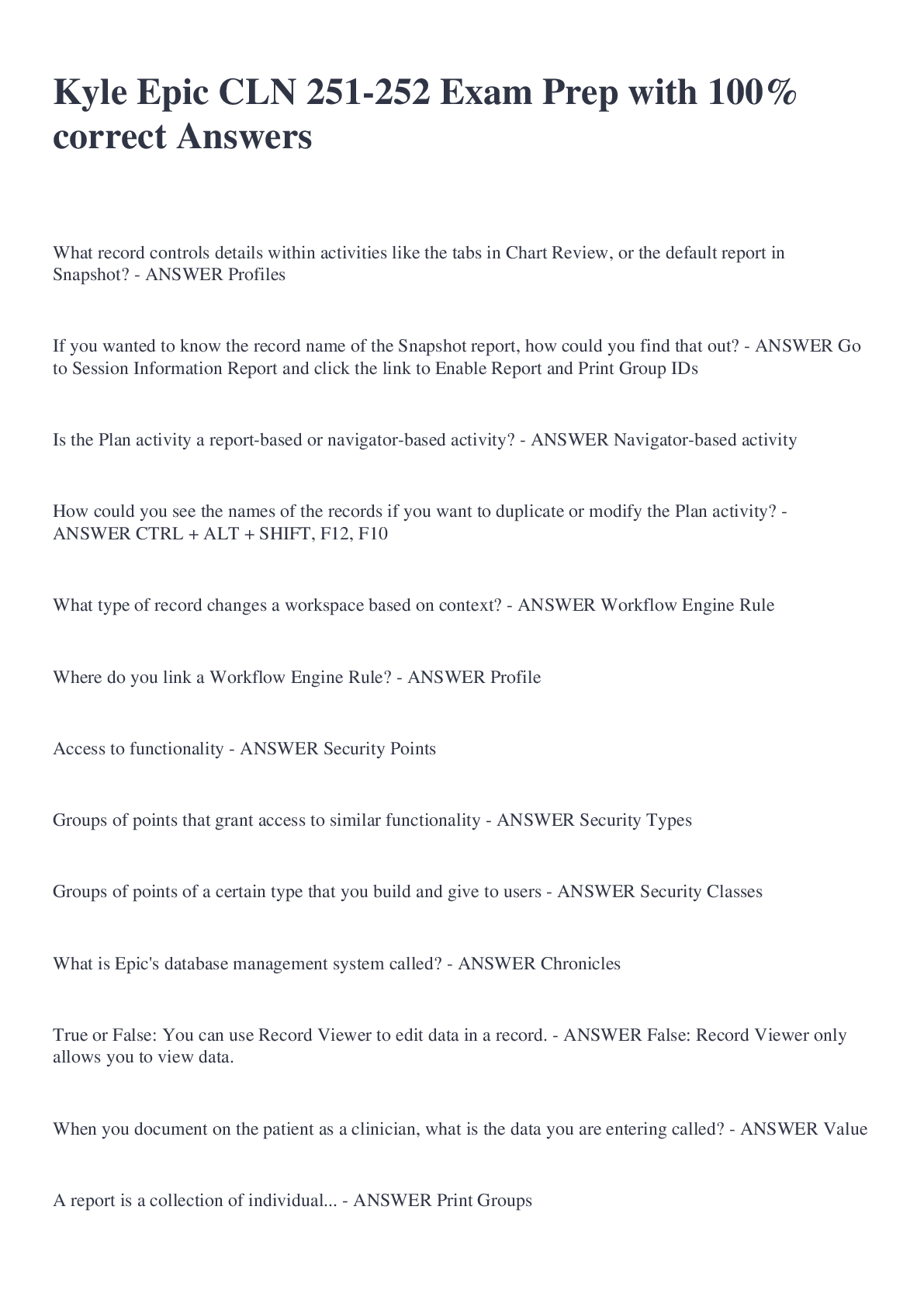
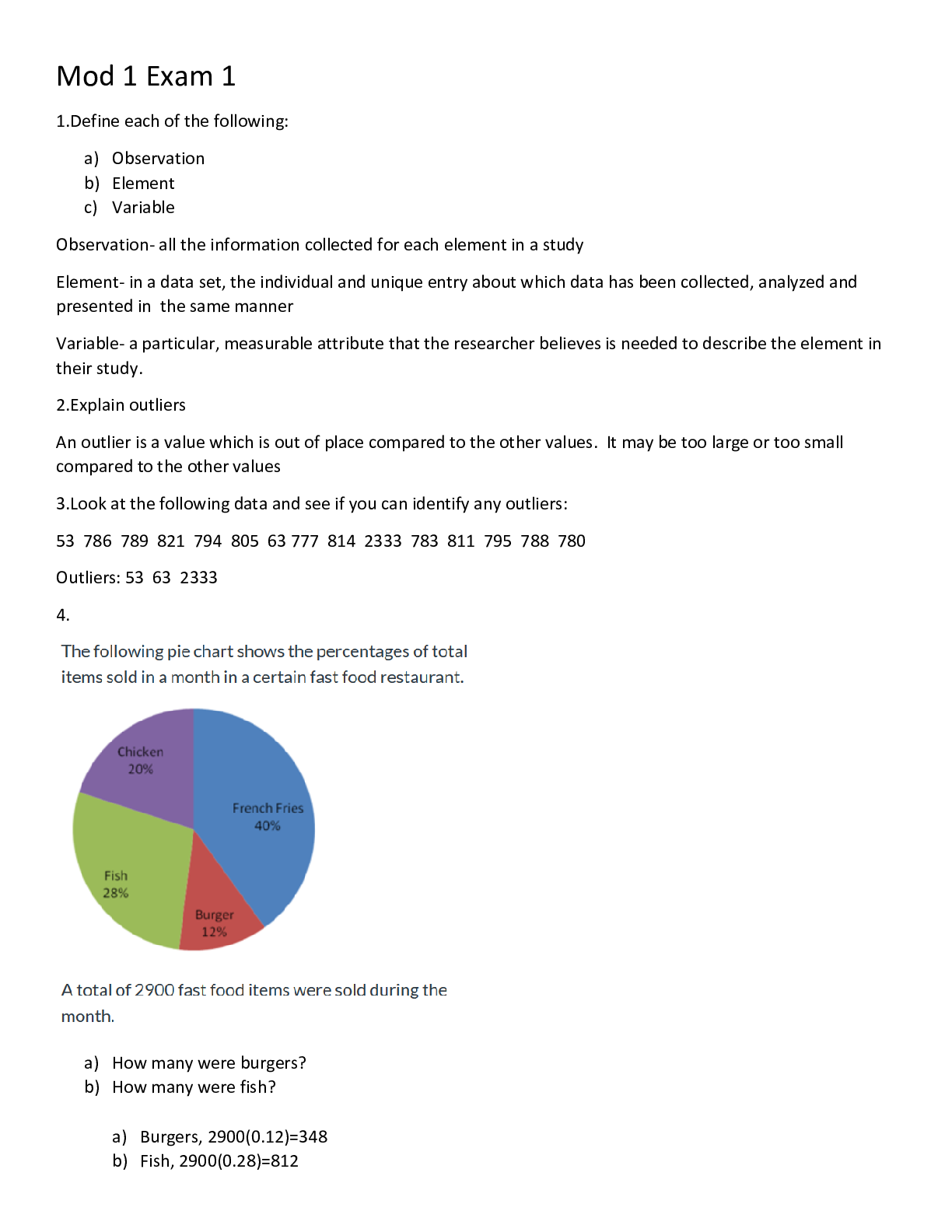

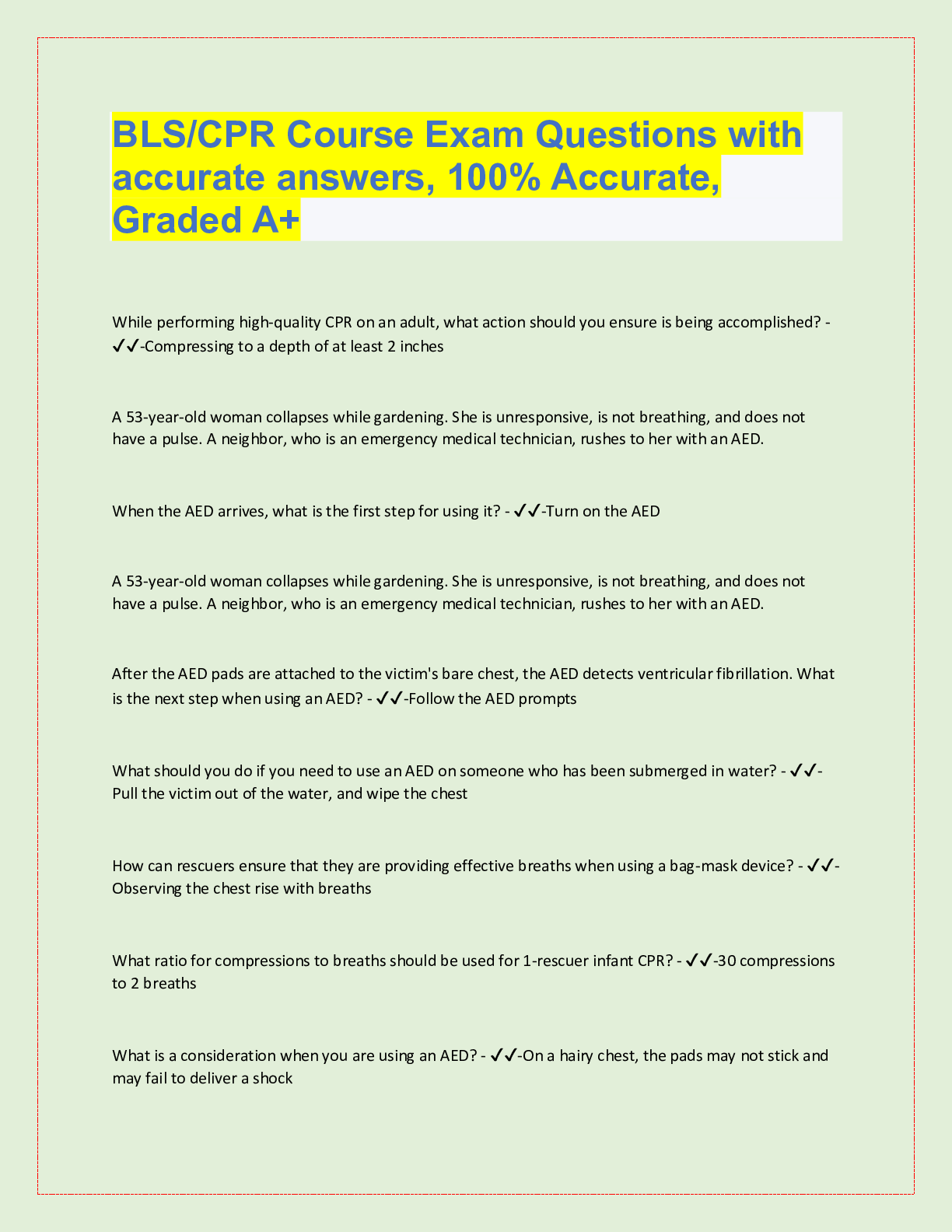

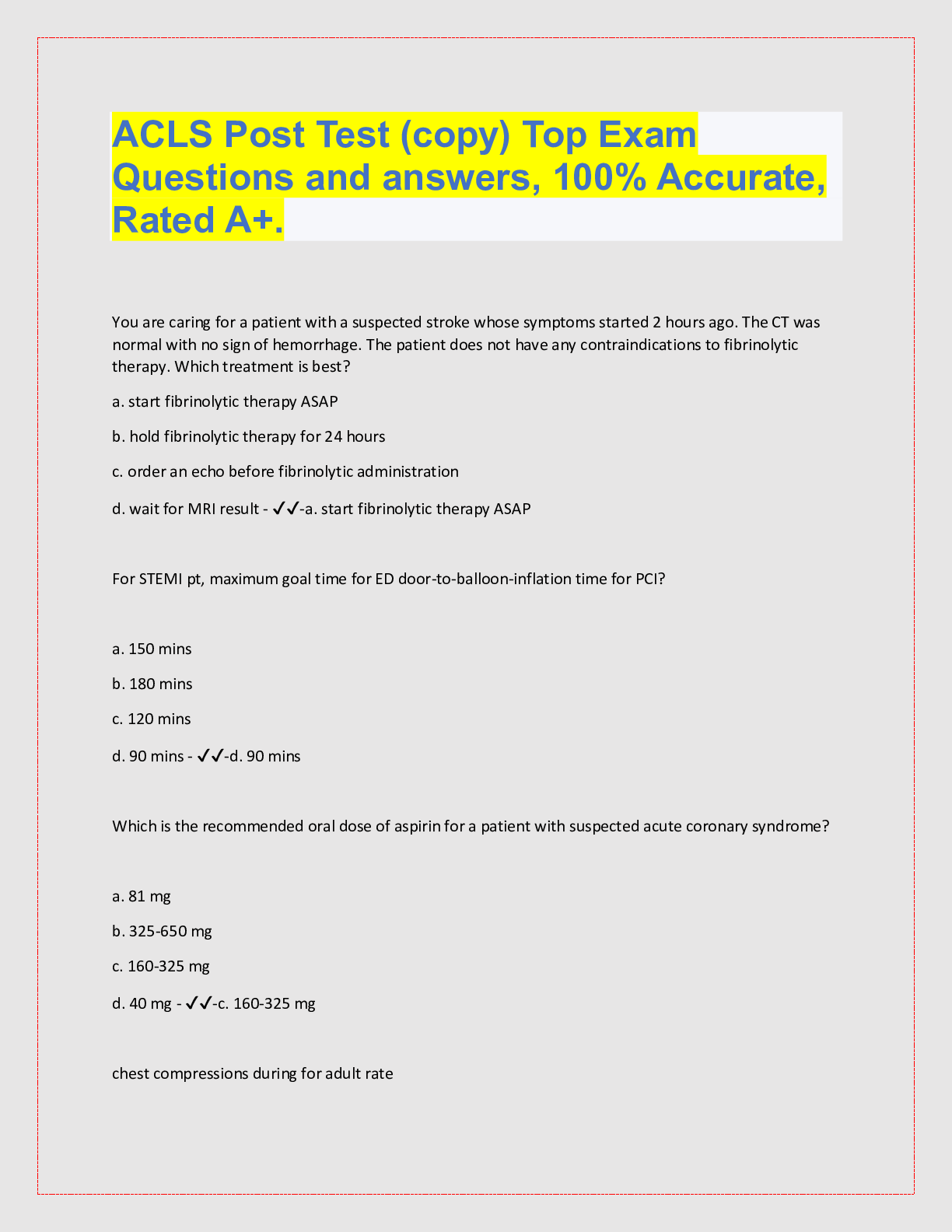
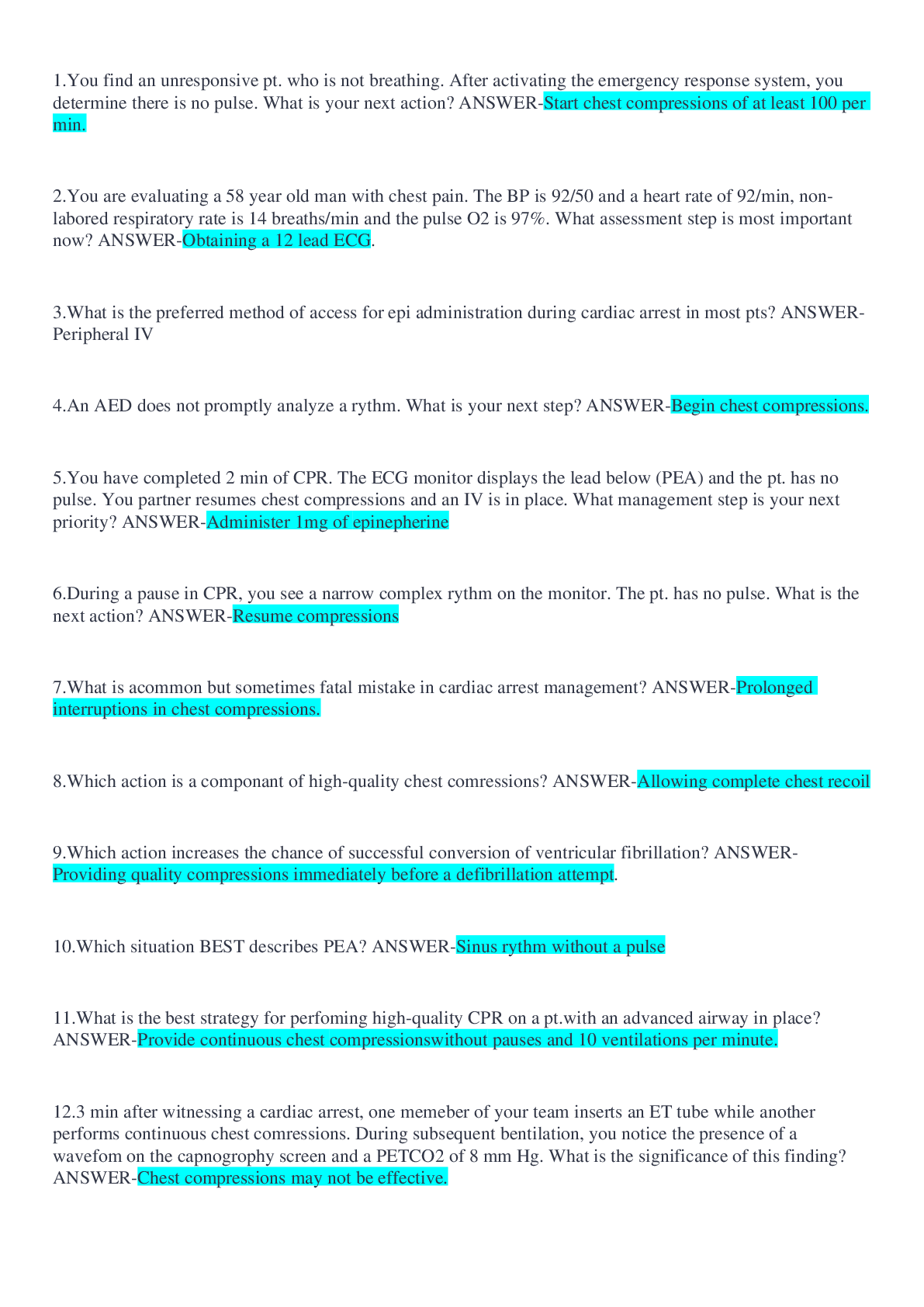
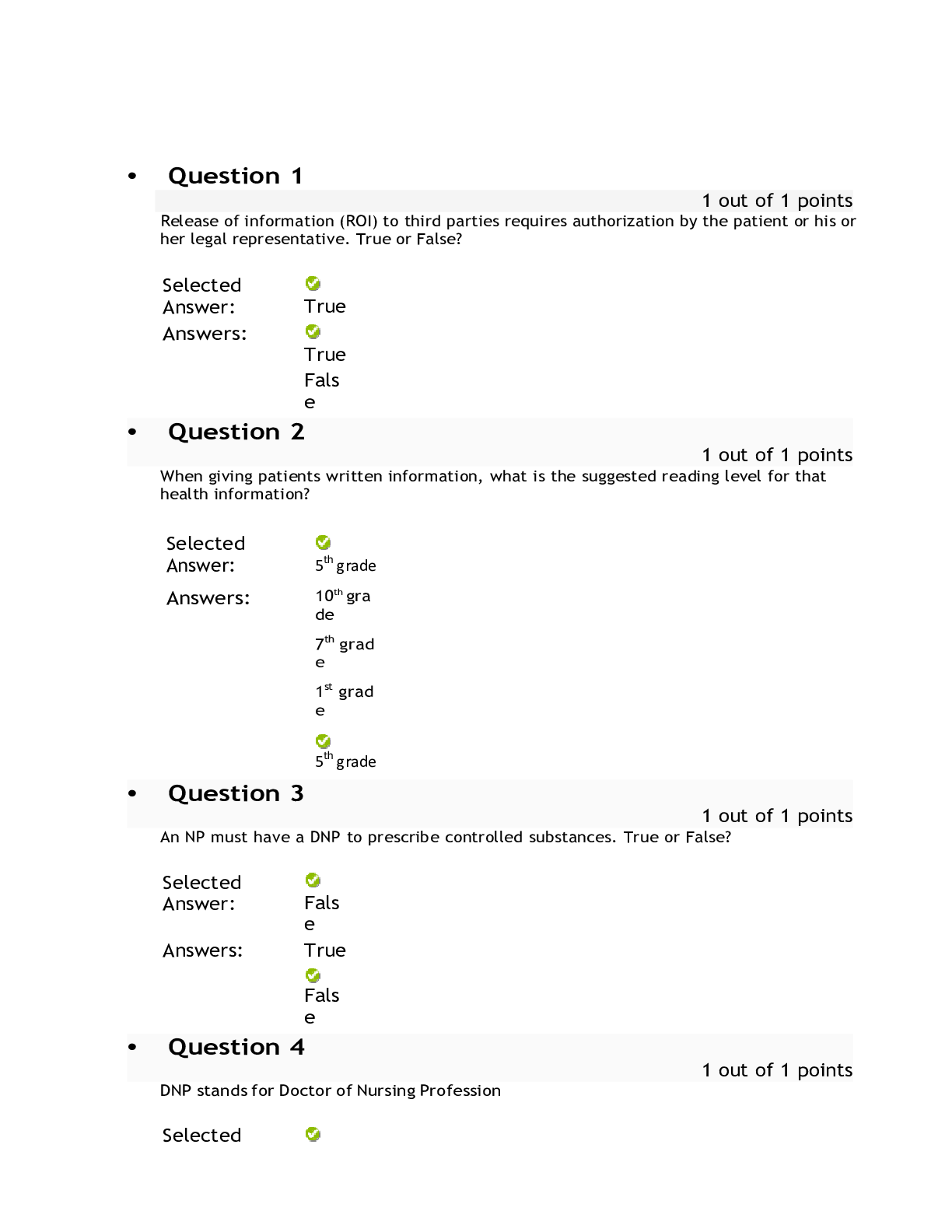
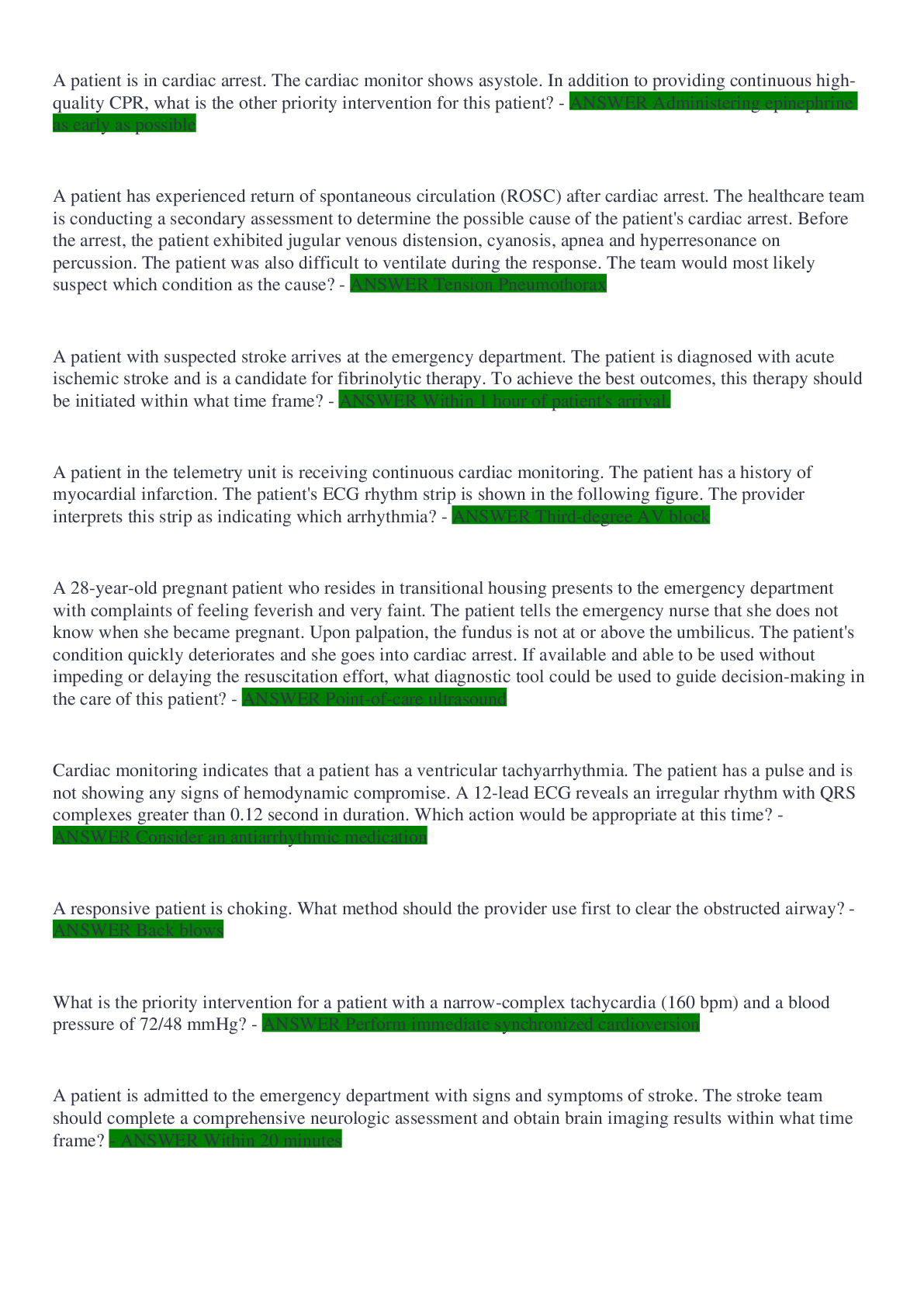




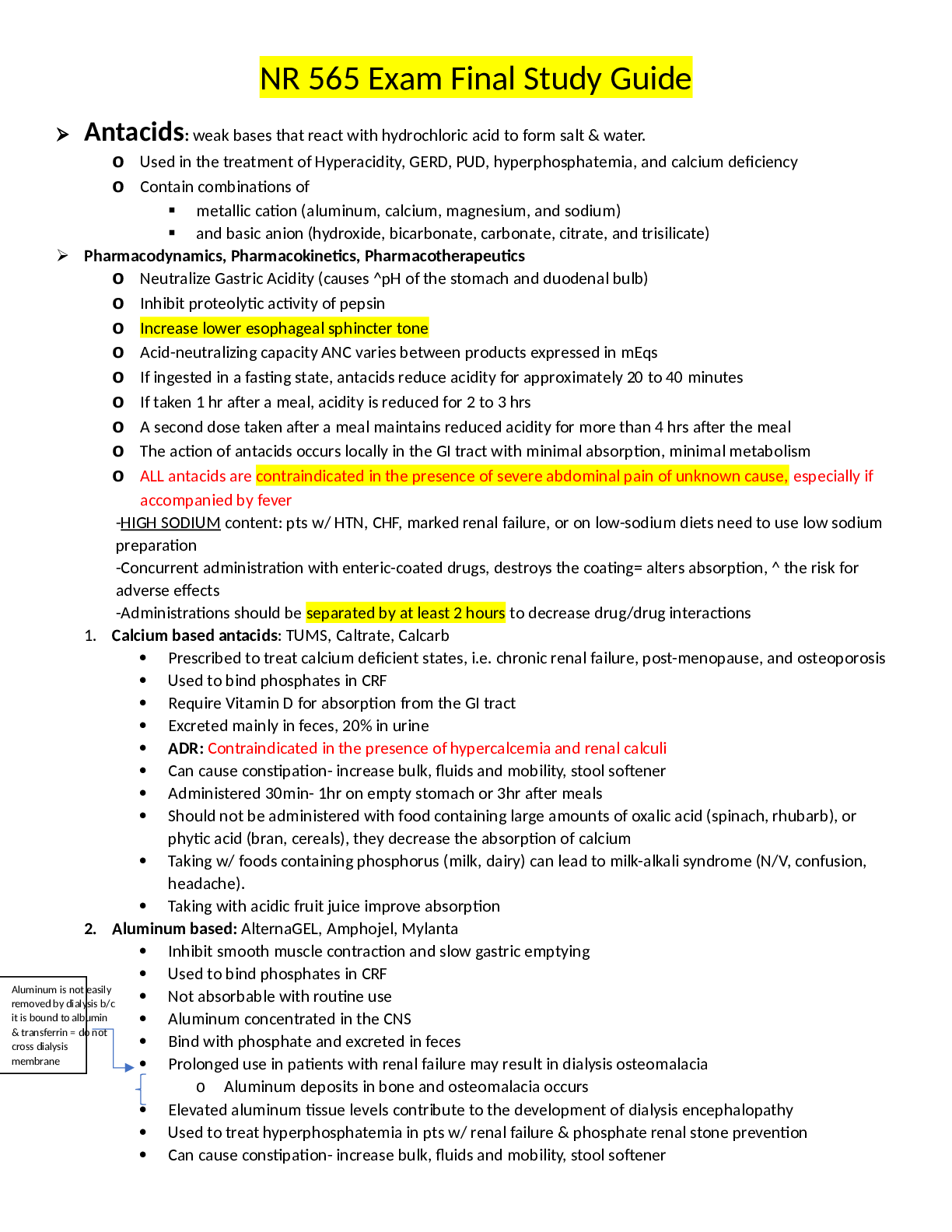
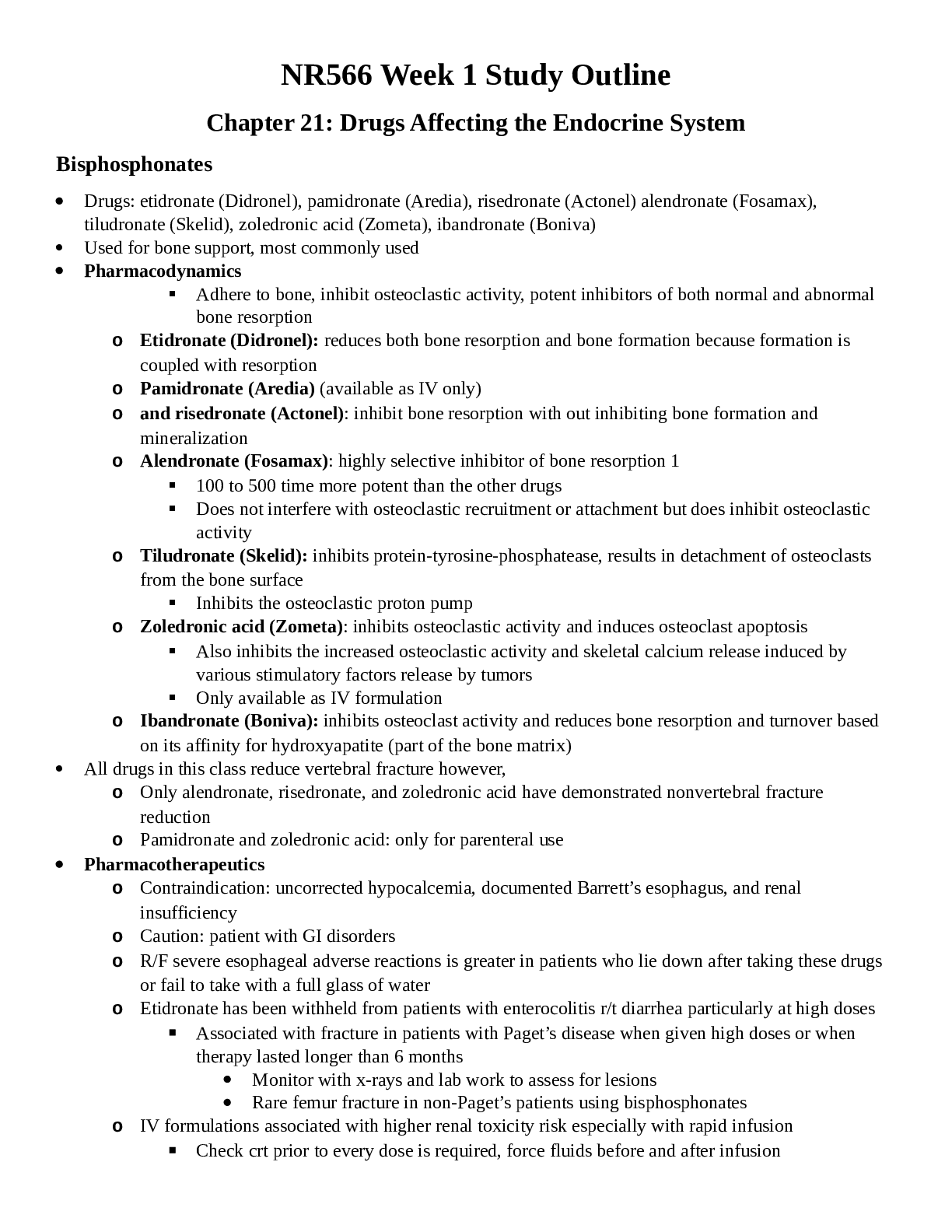
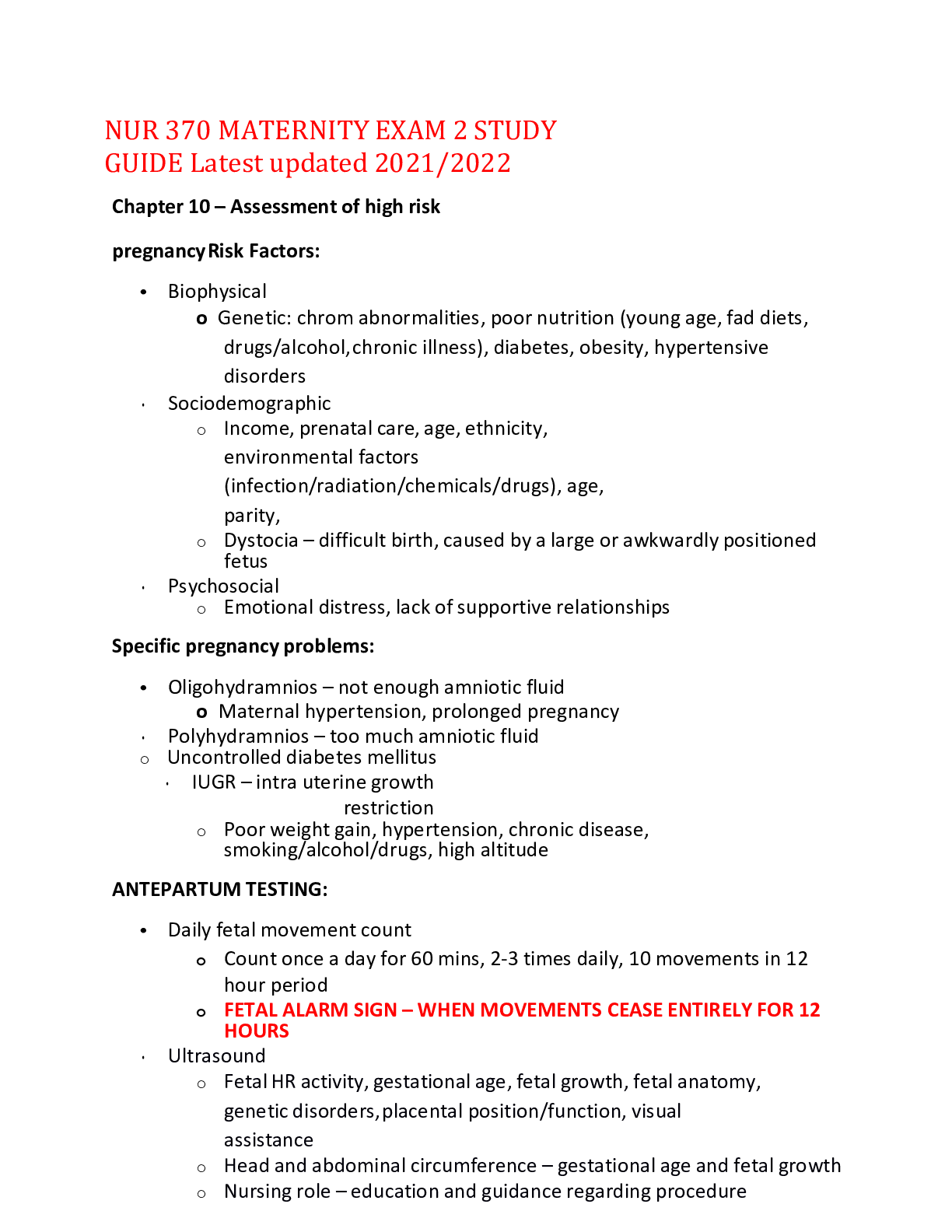
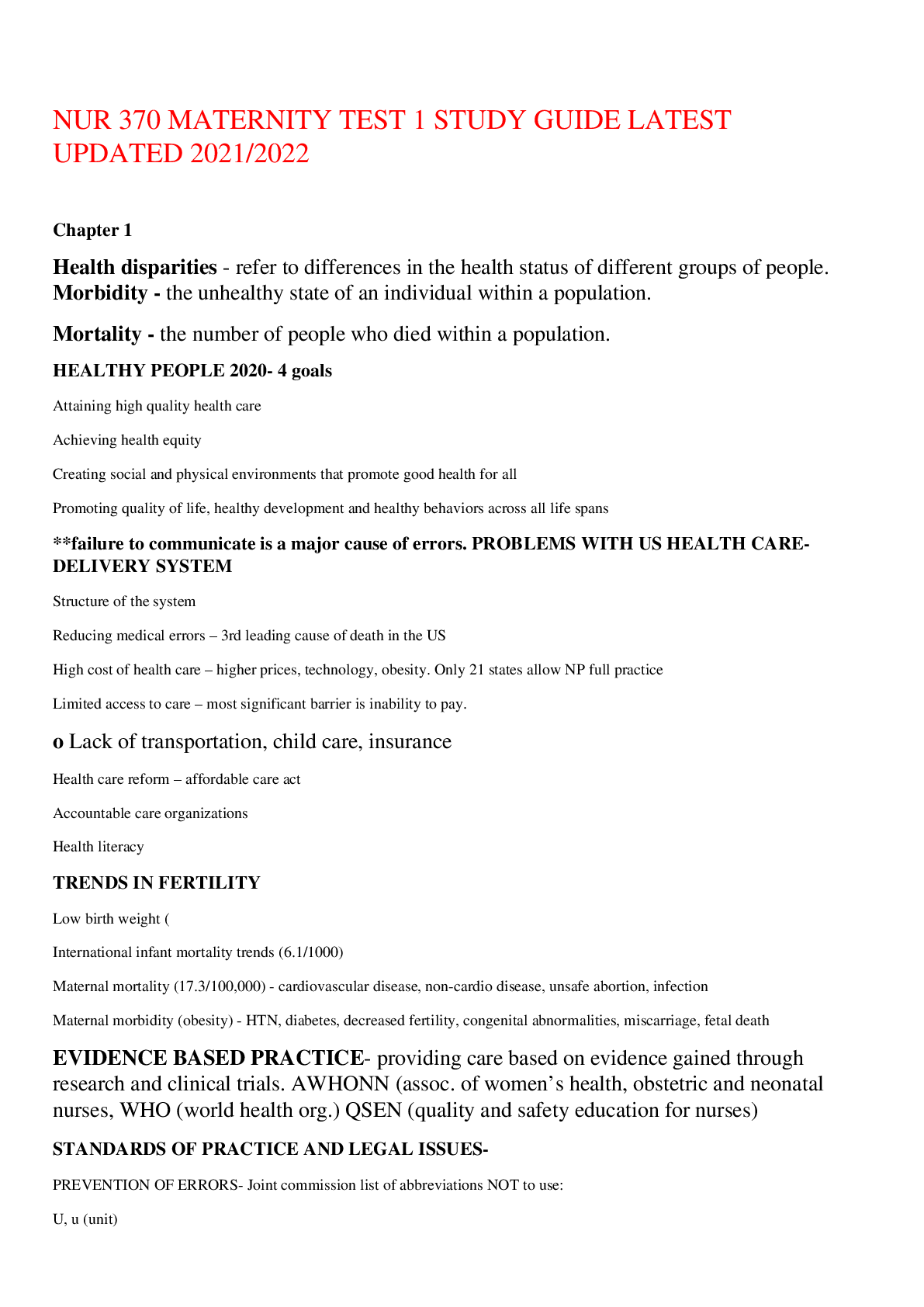
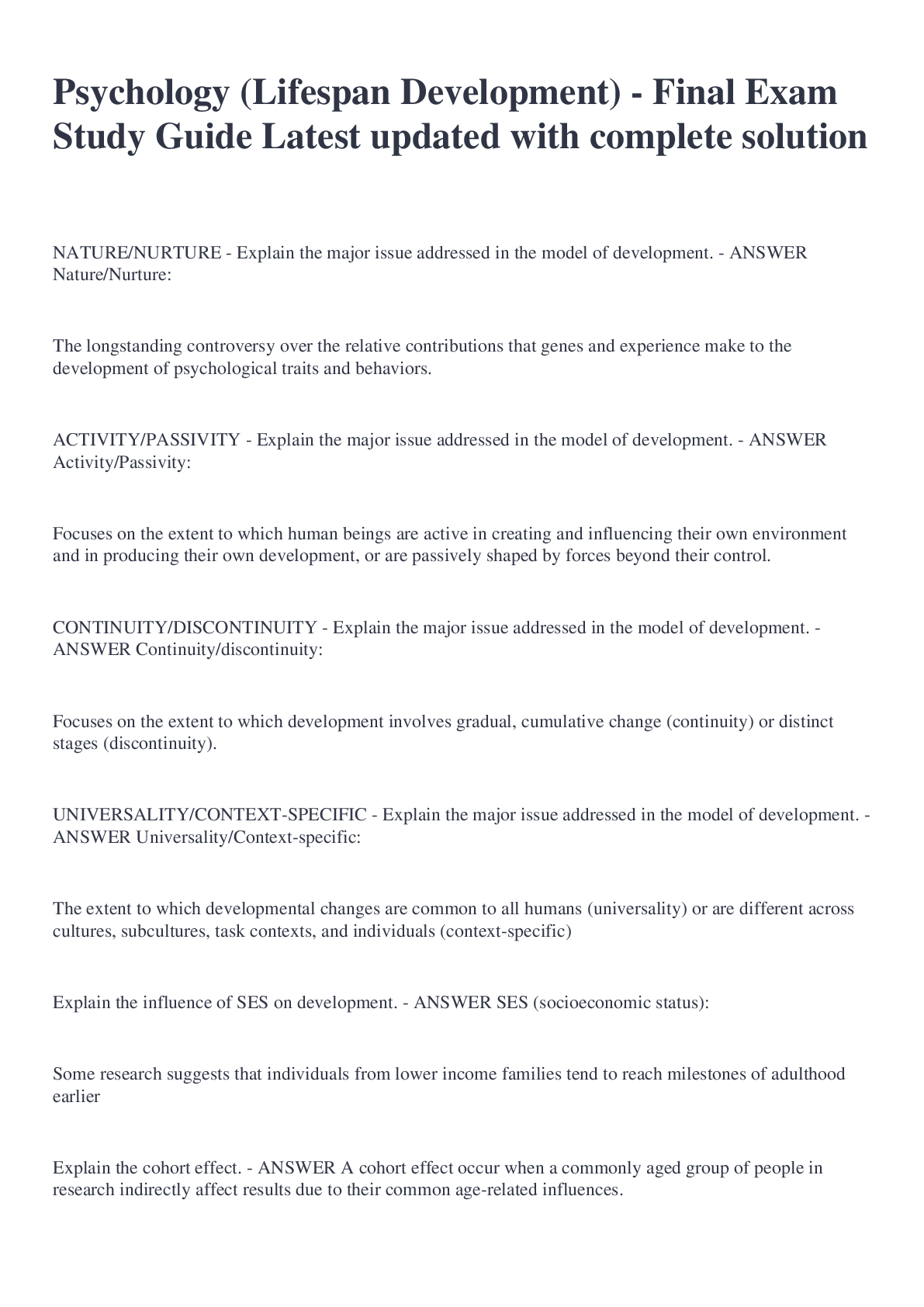
.png)
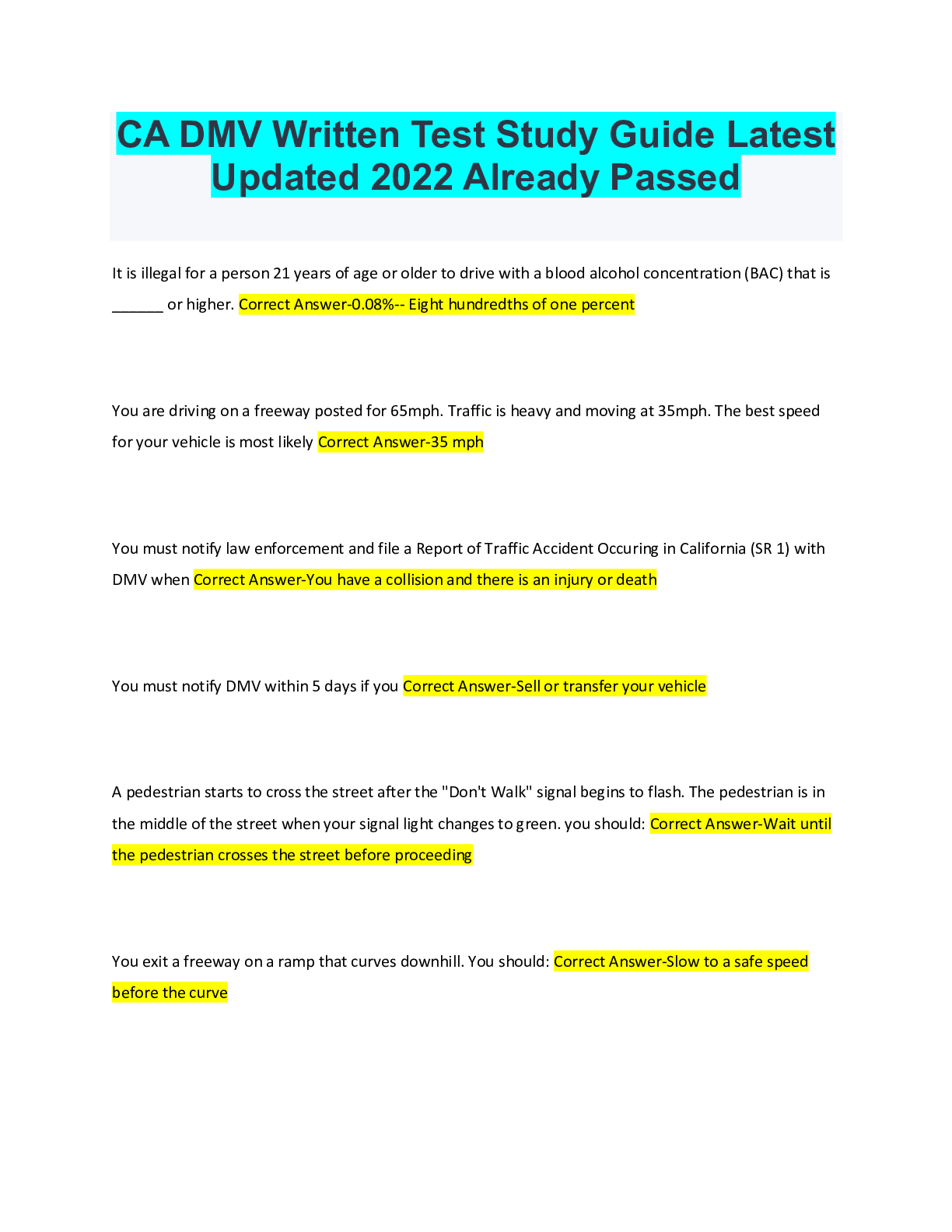
.png)

